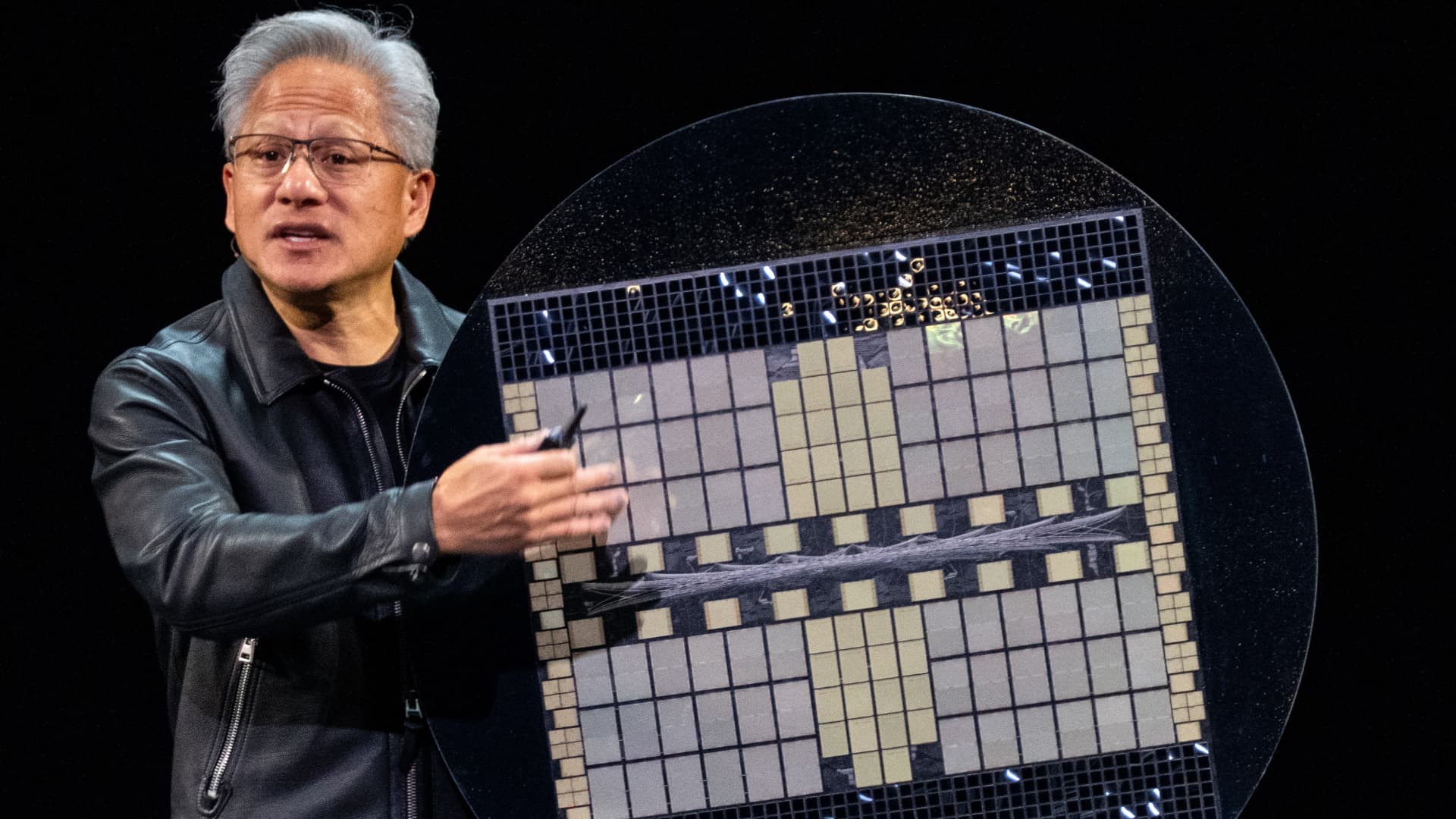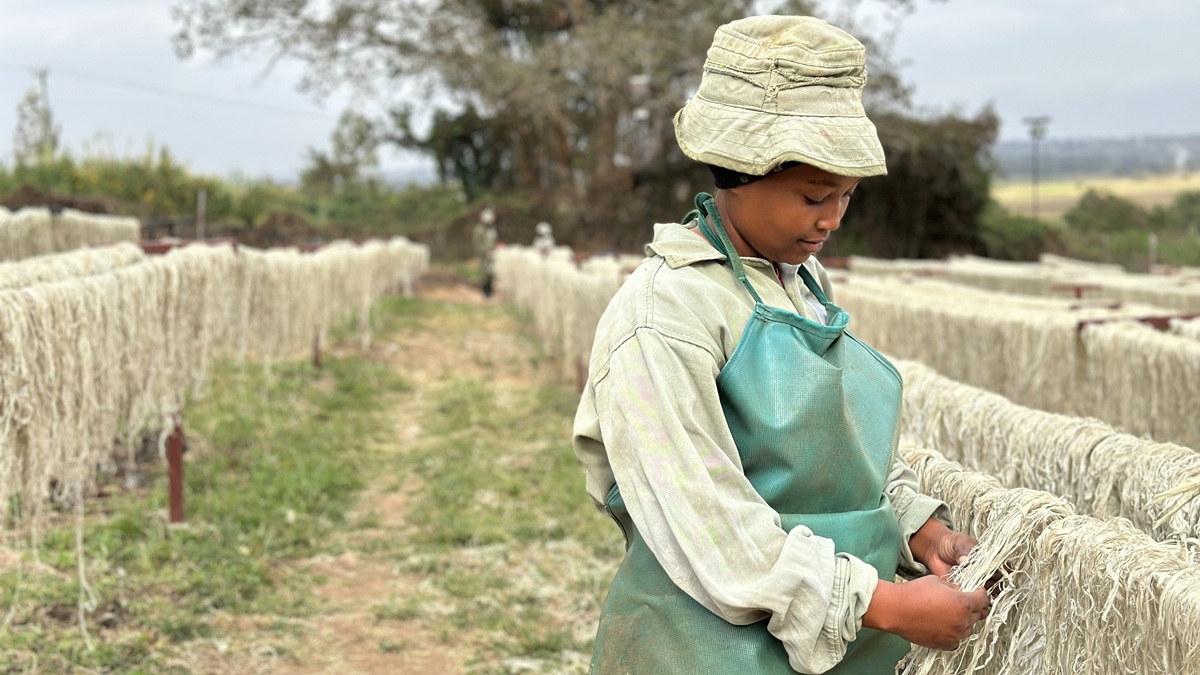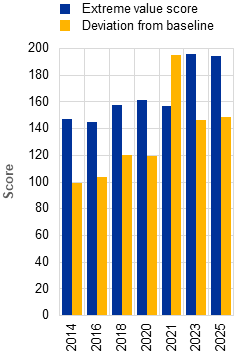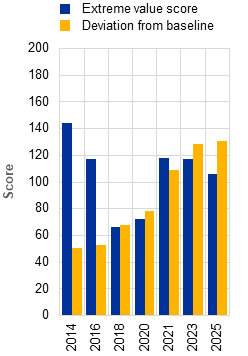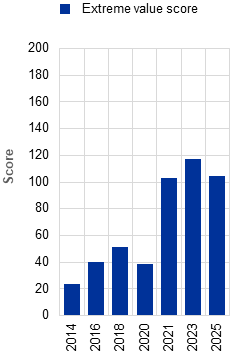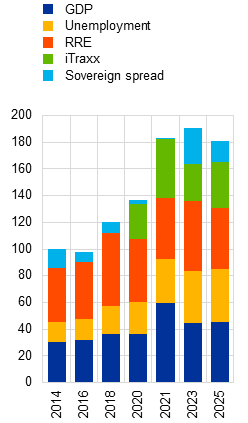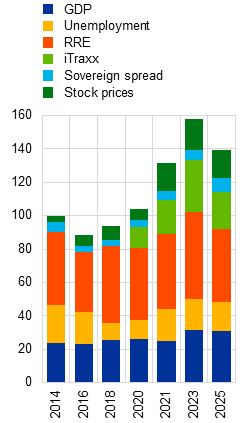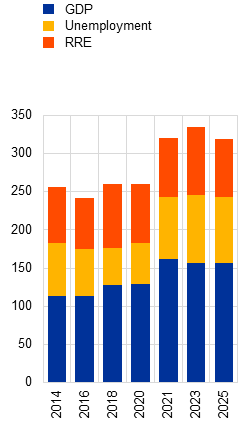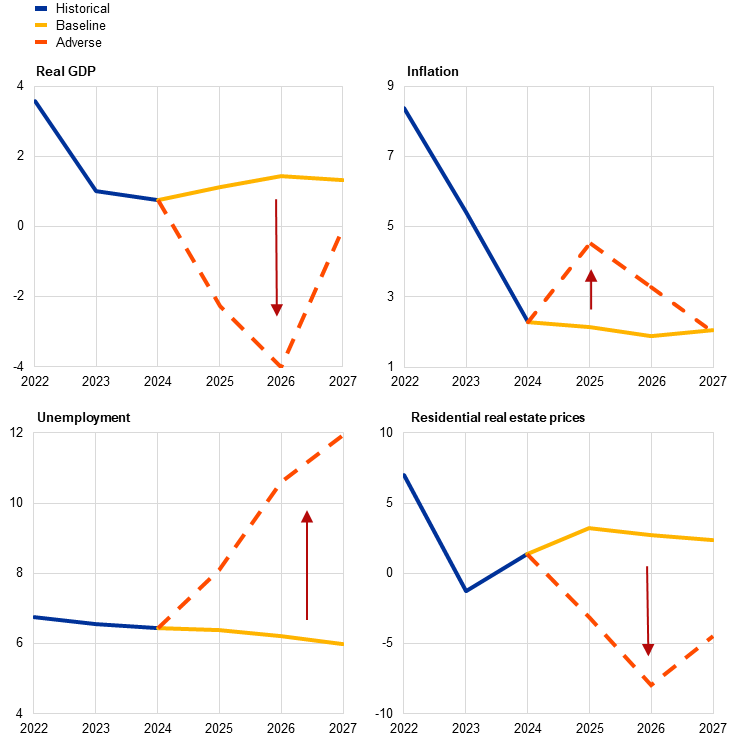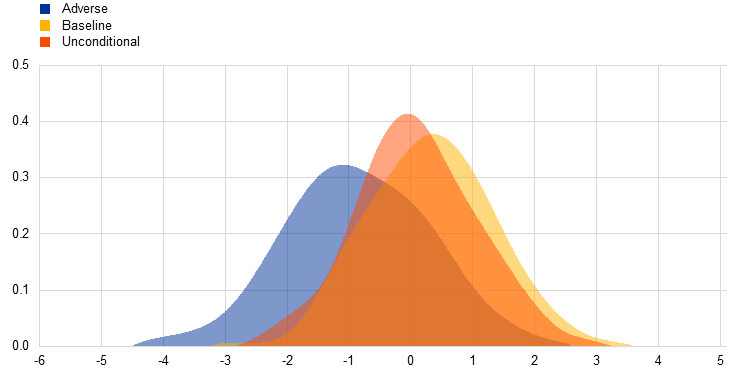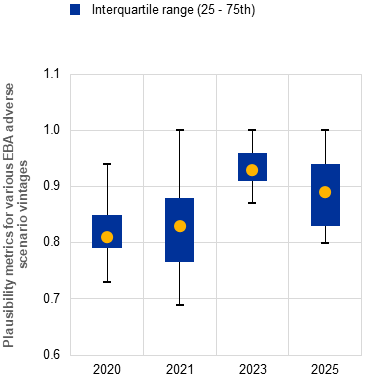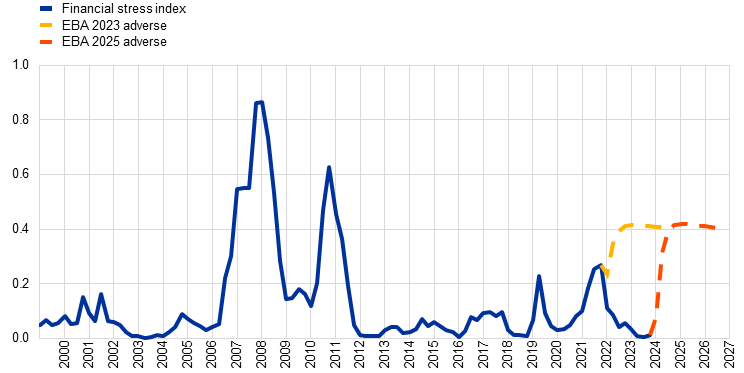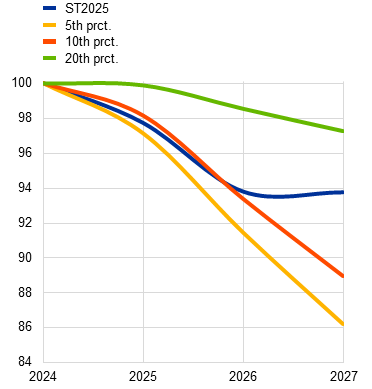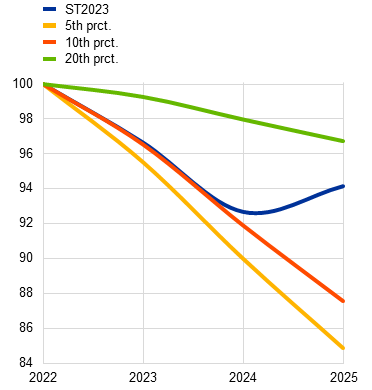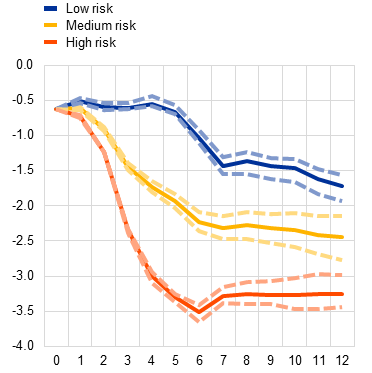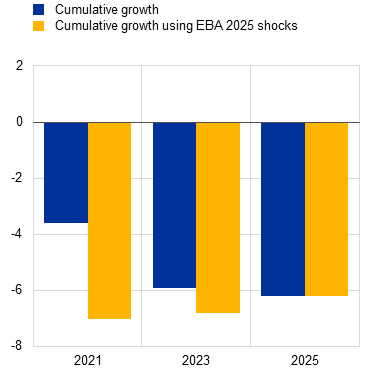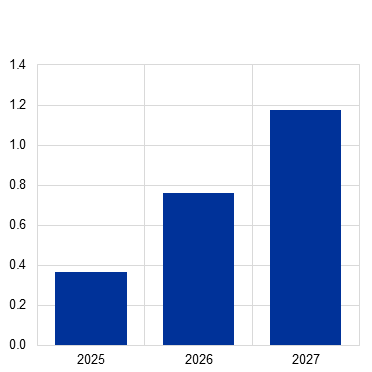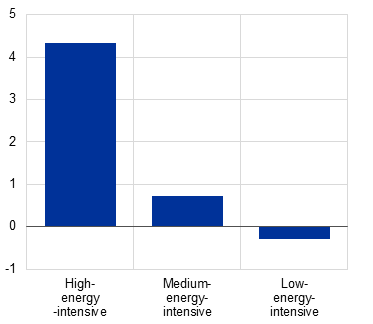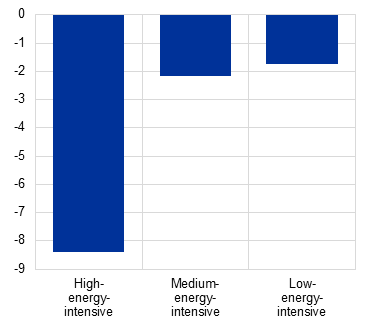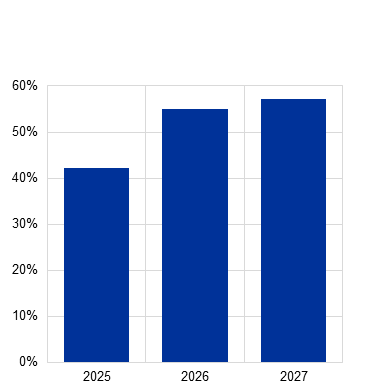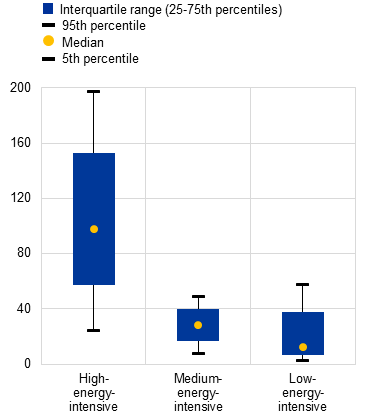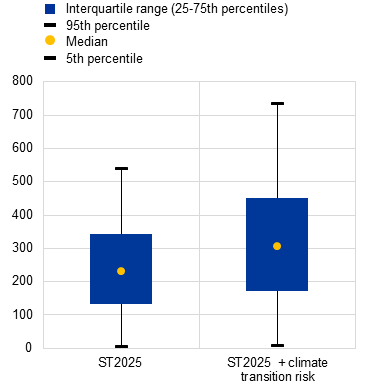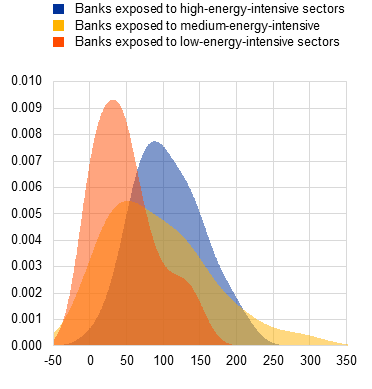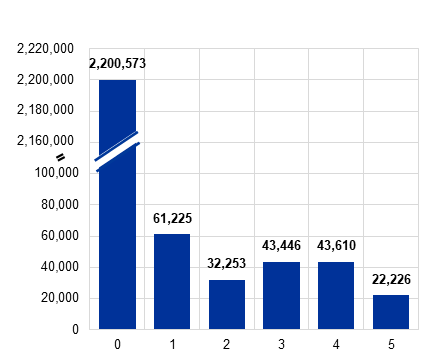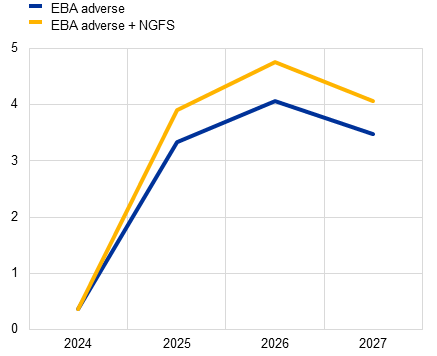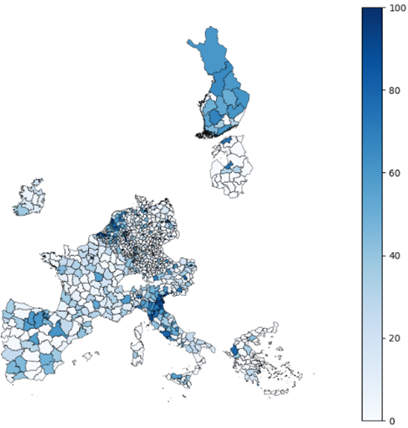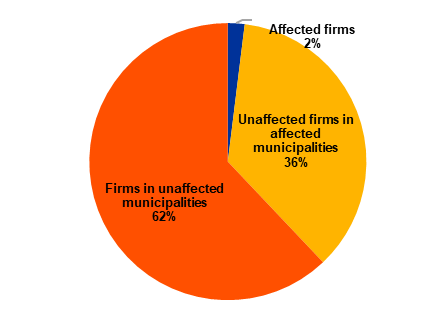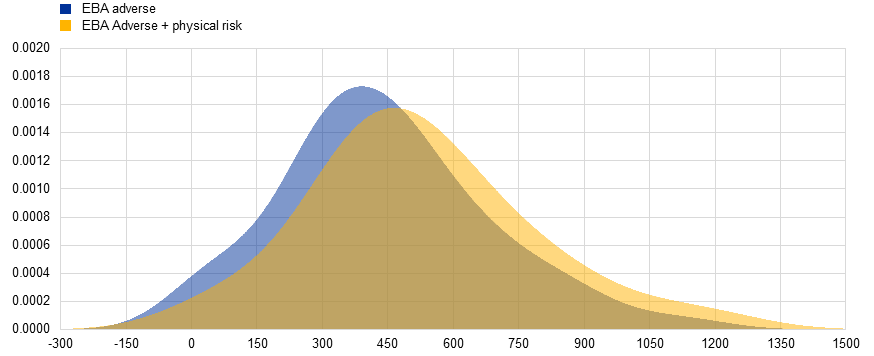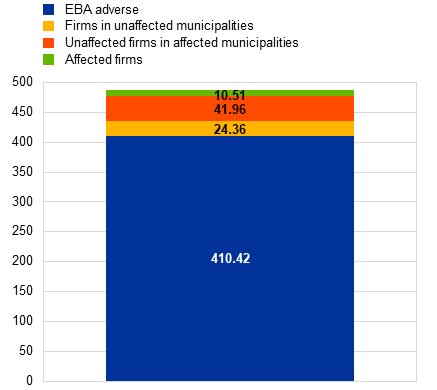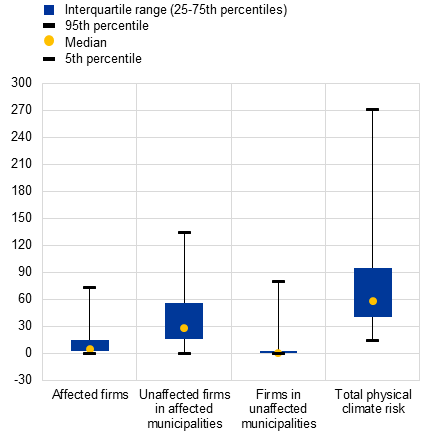Prepared by Juan Manuel Figueres, Barbara Montero Prieto, Valerio Scalone, James ’t Hooft, Lucas ter Steege and Clarissa Vallotto
Published as part of the Macroprudential Bulletin 32, November 2025.
The severity and the plausibility of stress test scenarios are crucial elements for interpreting the results and ensuring the credibility of stress-testing exercises. This article introduces a comprehensive framework for assessing scenario severity and plausibility in the context of the adverse scenarios used in the EU-wide stress tests. Two families of indicators are developed, characterised by a backward-looking and a forward-looking perspective. Backward-looking indicators compare the scenario with historical regularities, using as key metrics deviations from baseline projections and comparisons with the extreme values of key variables. Forward-looking indicators are drawn from macroeconomic modelling and compare the scenario with projected distributions about future economic developments incorporating the co-movement of variables within a unified analytical framework. These forward-looking metrics enable the severity assessment to account for the prevailing financial conditions and the level of systemic risk in the economy. The analysis presented suggests that the adverse scenarios used in the EU-wide stress tests have become more severe over time, peaking in the 2023 exercise and stabilising in 2025. Taking into account systemic risk, the 2025 scenario appears to be slightly more severe than the 2023 scenario. Overall, the article supports the idea of fostering a more effective definition, monitoring and communication of scenario severity, thereby strengthening the policy relevance and transparency of stress-testing exercises.
1 Introduction
Adverse scenarios for EU-wide stress tests need to be sufficiently severe yet plausible. The two concepts of severity and plausibility are interrelated. Severity is defined as the magnitude of the stress event, measured against a specific reference level (e.g. historical stress episodes, starting points and possible future outcomes). Plausibility refers to the validity (likelihood) of an extreme stress event, which can also be assessed by considering the specific risk environment underlying the scenario narrative. In terms of evaluating these two scenario requirements, backward-looking metrics are informative about the level of severity with respect to historical events, while forward-looking metrics assess both severity and plausibility by explicitly quantifying the tail risks which materialise in the adverse scenario.
A comprehensive assessment of scenario severity and plausibility is important when communicating the underlying assumptions of such scenarios. Understanding the severity of a scenario is essential for interpreting stress test results and for comparing the evolution of capital depletion across different exercises. The macro-financial scenario for the EU-wide banking sector stress test published by the ESRB measures severity in terms of real GDP cumulative growth across the scenario horizon.[1] The scenario for the 2025 Bank Capital stress test published by Bank of England does not explicitly discuss severity but provides reference historical figures for the global financial crisis along with the scenario paths.[2] These approaches, while informative, may not provide a complete assessment of scenario severity. By contrast, this article presents a more comprehensive framework for severity and plausibility evaluation which considers the multi-variable, multi-country and systemic risk dimensions of the EU-wide stress test scenario. It does so by leveraging on indicator-based methods and macroeconomic modelling. Such approaches help to ensure that scenarios correctly balance sufficient severity to rigorously test the resilience of the banking sector with plausibility in a realistic macro-financial environment. Overall, this approach aims to enhance the clarity and robustness of stress test scenario evaluation, ensuring that stress test scenarios remain both credible and relevant.
In the context of banking sector stress tests, the severity of the scenario must be kept separate from banks’ capital depletion. Bank losses depend not only on the severity of the scenario but also on the sector’s exposure to specific risks and its structural imbalances.[3] Additionally, scenario severity does not inherently account for cases where shocks, while negative for the broader economy, might have a positive impact on banks, such as rising interest rates which can improve net interest margins. These nuances highlight the need to carefully distinguish between the assessment of scenario severity from a macroeconomic perspective and the subsequent assessment of its impact on financial stability and bank solvency.
This article presents a framework to assess scenario severity and plausibility by comparing macro-financial dynamics with past observed dynamics or future developments. In the backward-looking approach, scenario severity is assessed in terms of the absolute past levels of key macroeconomic variables (e.g. GDP, unemployment, inflation) or of their deviation from a pre-defined baseline. This notion of severity focuses on the extent to which the scenario simulates a challenging economic environment, capturing the magnitude of potential stress on the economy as a whole and comparing with past stress events. The forward-looking approach maps the adverse scenario in the distribution of future events, assessing how far the adverse scenario extends in the tail of forecast distribution of potential outcomes, thus reflecting the probability of the shocks considered to generate the scenario itself. Importantly, in the forward-looking approach, systemic risks can affect the forecast distribution and the assessment of the severity in terms of tail event.[[4]],[[5]]
As risks and financial conditions shape the distribution of macroeconomic dynamics, they should also inform forward-looking severity assessments. Financial stability risks affect macroeconomic dynamics and, hence, the forecast distribution,[6] influencing where the adverse scenario stands in terms of the tail of said distribution. By leveraging non-linear macroeconomic models, this article presents severity measures which consider the evolution of financial conditions and systemic risks, complementing the forward-looking severity assessment with a risk-adjusted perspective.
The framework suggests that the severity of the EBA’s stress test scenarios has increased over time, with the 2023 and 2025 scenarios standing out as the most severe. Notably, when using non-linear techniques to account for systemic risk and financial conditions at the starting point of the scenario, the 2025 scenario emerges as the most severe.
2 A backward-looking perspective: measuring severity with respect to past events
An indicator-based approach is a straightforward way to assess the severity of scenarios. Originally proposed by Durdu, Edge and Schwindt (2017) in the context of Federal Reserve scenarios, this approach can be adapted to the case of the euro area. Compared with the original methodology, which focuses on a small set of variables, the adapted framework incorporates a broader range of indicators and, in one version, explicitly considers the impact on capital depletion.
Historical episodes of economic stress, such as recessions, serve as benchmarks to define severe adverse scenarios and build severity indices. Examining the evolution of key variables allows the average of mild episodes to be assigned a score of 0, while the most severe episode can receive a score of 100.[7] This scoring system establishes a scale against which the variables in an adverse scenario can be indexed.[8] Based on this scoring system, severity indicators can be computed for single variables or as averages across a set of variables in the scenario.
The results reveal a clear trend of increasing scenario severity over time. When the indices of individual scenario variables are examined, the two most recent stress-testing exercises rank as the years with the most severe scenarios (Chart 1). This result is confirmed when considering indices built by averaging across a broader set of variables, whether measured by the deviation of the scenario from its baseline or by the extreme values observed within the scenario (Chart 2). Severity also increases over time when averaging across variables to account for each variable’s sensitivity to capital depletion in banks (Chart 2, panel b). For instance, an equivalent change in GDP may have a substantially different impact on overall capital depletion than a similar change in residential real estate prices. This variability can be addressed by constructing a weighted average severity index, where the weights are based on each variable’s estimated sensitivity to capital depletion.
The severity index varies depending on the combination of variables and the choice of reference region but confirms a trend increase in severity. Region-specific severity indices display particularly high dispersion, reflecting differences in the historical episodes of economic stress experienced by each region.
3 A forward-looking perspective: using macro-econometric models to define severity measures
3.1 Leveraging joint probability concepts to assess scenario severity and plausibility
Scenario severity and plausibility can be assessed by using joint probability models of the relevant scenario variables. The severity and plausibility of a given scenario can be judged within a joint framework to properly account for the dependency structure between variables. To this end, a vector autoregressive (VAR) model for several variables of the EBA’s stress test scenarios is used to (i) estimate co-movements among variables in a consistent framework, and (ii) provide an estimate of the joint probability of the variables.[9],[10]
Scenario plausibility can be judged by the changes to the model’s shock distribution needed to match the adverse scenario paths. From the viewpoint of a VAR model, scenarios are ultimately conditions on some or all variables of the system (at several points in time) that the model ought to match by adjusting the model’s shock distribution. This adjustment can be measured using the approach set out by Antolín-Díaz et al. (2021) that is termed the divergence metric (DM), given its close connection to the Kullback-Leibler divergence. Intuitively, it can be interpreted as judging a scenario as the outcome of a biased coin flip. A metric value of 0.5 indicates no bias, such that the adjusted shock distribution is identical to the initial one. A value of 1, by contrast, indicates that one needs to push the shock distribution very far from its unconstrained counterpart. As such, high values of this metric indicate a low degree of plausibility as the shocks that implement the adverse scenario are then unlikely under the baseline distribution. Within the context of stress test scenarios, however, this can be interpreted interchangeably with scenario severity as the adverse is typically located in the lower tail of the baseline distribution.
In simple terms, the DM measures the effort required to move the baseline scenario to recreate the variable paths of the adverse scenario. The initial shock distribution is defined to implement the annual baseline scenario paths reported in the official stress test documents.[11] The deviations from this distribution, illustrated in Chart 3, are then interpreted as a measure of scenario plausibility.[12] For the baseline scenario in Chart 3, panel a, the method yields a shock distribution (yellow curve) with a slightly higher mean but close to the unconditional one (blue curve), which follows a standard normal distribution. In a second step shown in Chart 3, panel b, the shock distribution is shifted to the left to generate the shock distribution for the adverse scenario (red curve). The DM then computes the distance between the baseline and the adverse shock distribution. The final measure is computed across euro area countries, periods and variables.
The DM indicates that scenario severity increased over time but declined with the EBA’s 2025 stress test adverse scenario. Chart 4, panel a) compares the model-based scenario DM for the 2020, 2021, 2023 and 2025 exercises for the euro area. For the 2020 adverse scenario, the DM comes out at 0.81. In the following exercise (2021), scenario severity then slightly increased as shown by the rightward shift from the blue to the yellow distribution. The 2023 exercise saw a substantial increase in severity (the red distribution) with a modal metric around 0.93. The latest scenario (2025) features a severity metric close to 0.90, in the ballpark of 2023 but slightly smaller. For reference, Antolín-Díaz et al. (2021) find a scenario with a modal value of 0.83 to be “… unlikely but not completely implausible”. Hence, the DM values obtained here seem reasonable, not least because we are analysing severe stress test scenarios.[13]
The EBA’s 2025 adverse scenario provides a well-calibrated level of severity across euro area countries. Chart 4, panel b) focuses on the cross-country dispersion of the model-based scenario plausibility metric. The 2021 scenario features a marked increase in dispersion compared with the 2020 vintage, consistent with high uncertainty following the pandemic period shortly before. Both vintages feature plausible, and hence rather mild, country-level scenarios. The 2023 scenario vintage is more severe across the board, as shown by an upward shift and compression of the distribution. The 2025 scenario features somewhat higher dispersion than the 2023 vintage and overall turns out to be more plausible/less severe. However, the 2025 DM is still close to the 2023 vintage DM. The 2025 scenario lies above 0.8 in the cross-section, a value that, as illustrated in the previous paragraph, can be considered a sensible lower bound on a scenario believed to be “severe, but plausible”. As such, the 2025 scenario seems to provide a consistently severe scenario in the cross-section.
3.2 Risk-adjusted forward-looking severity: adjusting severity by considering risks to financial stability
When assessing the severity of a scenario, an economy’s level of financial risk at the start of the scenario horizon also needs to be accounted for. The level of financial risk affects how shocks propagate through the economy. Overall, when risks are higher, economic and financial shocks are amplified and are likely to lead to stronger downturns. This section assesses the severity of the stress test scenarios by using non-linear macro-econometric frameworks designed to evaluate the relationship between the level of risk and the macroeconomic outlook. In this way, the forward-looking severity assessment can be adjusted to take account of financial conditions and the prevailing level of systemic risks.
3.2.1 Combining forward-looking metrics with financial conditions within a growth-at-risk approach
Adverse scenarios are designed to reflect financial stability risks to which the EU banking sector is exposed.[14] A complementary approach to assessing the severity of these adverse scenarios therefore focuses explicitly on the risks that underpin the design of a specific scenario. This approach builds on the growth-at-risk framework (see Adrian et al., 2019, and Figueres and Jarocisńki, 2020), which entails constructing the predictive distribution of GDP growth conditional on the financial risks embedded in the scenario. The severity of the scenario is then assessed by comparing the projected GDP path under the scenario against the range of potential adverse GDP outcomes implied by the financial risks associated with this scenario.
The level of the financial risk associated with the scenario is measured by a financial stress index (FSI). Using the methodology of the Composite Indicator of Systemic Stress (CISS) presented in Holló et al. (2012),[15] an FSI is built to match the path of the adverse scenario variables for the euro area (Chart 5). The key advantage of the FSI lies in its ability not only to capture historical events of financial stress (e.g. the 2008 global financial crisis and the 2011 euro area crisis) but also to gauge the level of financial risk embedded in the scenario shocks. As shown in Chart 5, the 2023 adverse scenario starts from a situation of elevated risk in 2022 and exhibits a persistent increase in financial stress levels over the three-year scenario horizon. By contrast, the 2025 adverse scenario starts from a situation of relatively low financial risk in 2024, with a pronounced increase in financial stress that diminishes slightly towards the end of the scenario horizon.
A growth-at-risk measure of severity can be obtained by estimating density forecasts for GDP conditional on the level of financial risk conveyed in the scenario. A set of adverse outcomes can be derived by projecting future GDP conditional on the FSI via quantile regression. In particular, the outcomes corresponding to the predictive lower tail at the 5th, 10th and 20th percentiles are considered.[16] Chart 6 shows the predictive lower tails corresponding to the 2025 (panel a) and the 2023 (panel b) adverse scenarios.
From a growth-at-risk perspective, the 2025 adverse scenario appears more severe than the 2023 scenario. Chart 6 provides three main insights. First, the GDP paths for both the 2023 and the 2025 adverse scenarios lie within their respective predictive lower tails, indicating that, while both scenarios depict severe stress conditions, they remain plausible within the context of the underlying risks. Second, the predictive lower tails for the 2023 scenario are wider than those for the 2025 scenario, reflecting the elevated financial risk observed in 2022, which determined the initial conditions of the 2023 scenario as shown in Chart 6. Third, the GDP path for the 2025 scenario extends deeper into its predictive lower tail than the 2023 scenario, pointing to the 2025 adverse scenario having a higher degree of severity.
3.2.2 Combining forward-looking metrics with cyclical systemic risks in a local projection approach
The evolution of indebtedness and systemic risk levels plays a crucial role when assessing the severity of stress test scenarios. The level of cyclical systemic risks can affect the way macroeconomic dynamics propagate in the economy. Several studies highlight that when the level of debt is high, shocks are amplified in the economy, as debt plays the role of financial accelerator (see Bernanke at al., 1999, and Kiyotaki and Moore, 1997). When agents are more indebted, external shocks may affect their debt repayment capacity and force them to reduce spending, further amplifying the initial fluctuations.[17] Higher systemic risks may affect severity assessments, as in times of higher risks and higher vulnerability, the same scenario would be triggered by relatively smaller shocks than in a period of lower systemic risks.
When systemic risk levels are high, the same shocks tend to generate stronger recessions than in periods of low risk. A non-linear macroeconomic model is first utilised to examine how systemic risks influence the propagation of macroeconomic shocks (see Couaillier and Scalone, 2024). The model assumes that the economy smoothly transitions between periods of high and low levels of cyclical systemic risk, as captured by the systemic risk indicator (SRI) (see Lang and Forletta, 2020). Thanks to its non-linear structure, the SRI generates state-dependent dynamics. Chart 7, panel a) illustrates how under conditions of elevated cyclical systemic risk, the impact of shocks is overall significantly amplified, in line with the presence of a financial accelerator in the economy.
The level of cyclical systemic risk has decreased over recent years, driven by slower credit growth and downward asset price corrections. At the beginning of 2021, the observed SRI was high, at 0.06, explained by significantly expanding debt, falling asset price valuations and increasing private sector indebtedness. The SRI then started to fall from this peak. This downward trend continued during the period of monetary policy tightening in line with a deceleration in credit growth and an asset price correction. At the beginning of 2025, the euro area’s SRI was lower than in 2023 and 2021.
Taking into account cyclical systemic risk levels, the 2025 scenario emerges as more severe than the 2023 and 2021 scenarios. The model’s non-linear dynamics are used to compare the severity of the scenarios across the different years, once the level of cyclical systemic risk is incorporated. First, the non-linear model is used to match the negative cumulative GDP growth of the EBA’s 2025 scenario, including the risk level observed during the scenario calibration period. The same set of shocks required to match the 2025 scenario downturn is then used to compute the hypothetical cumulative GDP growth considering the risk levels for 2023 and 2021. Chart 7, panel b) reports the cumulative GDP growth under the original EBA adverse scenarios over the three-year stress test horizon for the 2021, 2023 and 2025 exercises (blue bars) and the hypothetical cumulative growth for each scenario (yellow bars). If the same set of shocks used in 2025, hence the same severity, had been used in the previous exercises, the cumulative GDP growth would have been 0.9 percentage points higher in 2023 and 3.0 higher in 2021.
4 Conclusion
This article introduces a comprehensive framework for assessing the severity and plausibility of the adverse scenarios used in the EU-wide stress tests, incorporating multiple dimensions to ensure a robust evaluation. First, backward-looking indicators are used to assess scenario severity by benchmarking the adverse scenario outcomes against historical crisis episodes. This backward-looking leg focuses on two critical dimensions: (i) the deviation of adverse outcomes in variables such as real GDP, unemployment and inflation from the baseline scenario; and (ii) the levels of these variables in the adverse scenario. These dimensions offer insights into both the relative and the absolute levels of stress embedded in the scenarios. A forward-looking leg assesses the severity of the scenario in terms of the future density forecasts. This leg relies on a model-based severity index constructed by leveraging a macroeconomic VAR model and the concept of scenario plausibility. The resulting plausibility metric evaluates how far an adverse scenario deviates from baseline expectations, providing an intuitive measure of their alignment with historical regularities and hence their realism.
The forward-looking severity assessment can be expanded to consider how systemic risks affect macroeconomic dynamics. To this end, the article presents a methodology for evaluating scenario severity that incorporates prevailing financial conditions and systemic risks. These approaches focus on cumulative GDP growth and give rise to two complementary measures. The first shows how financial conditions can affect severity assessments. A growth-at-risk approach compares the location of the scenario-implied GDP path in the lower tails of predictive distribution, providing insights into the severity of adverse outcomes relative to expected risks. The second measure studies how systemic cyclical risks can affect severity assessments. This approach computes how the cumulative GDP growth of the 2023 and 2021 scenarios would have differed if the same shocks used to generate the 2025 cumulative GDP growth had been used in 2021 and 2023, taking into account the relatively higher levels of systemic risk in those periods.
This framework finds that the adverse scenarios used in the EU-wide stress tests have become more severe over time. According to the indicator-based approach and the model-based plausibility index, scenario severity reached a peak in 2023 before declining slightly in 2025. Taking into account the financial risk environment that prevailed when the scenarios were devised, it turns out that the GDP path can be considered more severe under the 2025 scenario than under the 2023 scenario since it is located further into the tail of its predictive distribution. Moreover, when adjusting for systemic risk, the 2025 scenario appears to be the most severe, even surpassing the 2023 scenario in terms of its risk-weighted severity. This highlights the importance of considering systemic risk levels when evaluating scenario severity.
The proposed methodologies provide a multidimensional, rigorous framework for evaluating the severity and plausibility of stress test scenarios. By benchmarking against historical episodes, employing macroeconomic modelling and applying systemic risk adjustments, this framework helps scenarios to be devised that are both severe and plausible. This makes it easier to assess the resilience of the banking sector to adverse macro-financial developments while improving the clarity, credibility and comparability of stress test results.
References
Adrian, T., Boyarchenko, N. and Giannone, D. (2019), “Vulnerable Growth”, American Economic Review, Vol. 109, No 4, April, pp. 1263-1289.
Antolín-Díaz, J., Petrella, I. and Rubio-Ramírez, J.F. (2021), “Structural scenario analysis with SVARs”, Journal of Monetary Economics, Vol. 117, January, pp. 798-815.
Bernanke, B.S., Gertler, M. and Gilchrist, S. (1999), “The financial accelerator in a quantitative business cycle framework”, Handbook of Macroeconomics, Vol. 1, pp. 1341-1393.
Couaillier, C. and Scalone, V. (2024), “Risk-to-buffer: setting cyclical and structural banks capital requirements through stress tests”, Working Paper Series, No 2966, ECB.
Durdu, B, Edge, R. and Schwindt, D. (2017), “Measuring the Severity of Stress-Test Scenarios”, FEDS Notes, Board of Governors of the Federal Reserve System, 5 May.
Figueres, J.M. and Jarociński, M. (2020), “Vulnerable growth in the euro area: Measuring the financial conditions”, Economics Letters, Vol. 191(C), June.
Geweke, J. (1993), “Bayesian treatment of the independent Student‐t linear model”, Journal of Applied Econometrics, Vol. 8, Supplement, December, pp. S19-S40.
Holló, D., Kremer, M. and Lo Duca, M. (2012), “CISS – a composite indicator of systemic stress in the financial system”, Working Paper Series, No 1426, ECB.
Jarociński, M. (2010), “Responses to monetary policy shocks in the east and the west of Europe: a comparison”, Journal of Applied Econometrics, Vol. 25, Issue 5, pp. 833-868.
Kiyotaki, N. and Moore, J. (1997), “Credit Cycles”, Journal of Political Economy, Vol. 105, No 2, April, pp. 211-248.
Lang, J.H. and Forletta, M. (2020), “Cyclical systemic risk and downside risks to bank profitability”, Working Paper Series, No 2405, ECB.
Ter Steege, L. (2024), “Variational inference for Bayesian panel VAR models”, Working Paper Series, No 2991, ECB.

